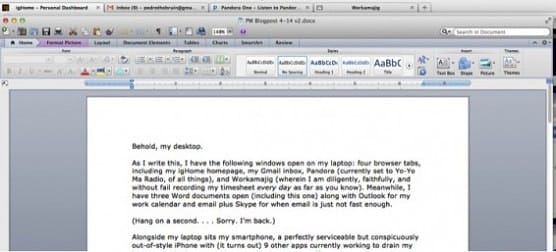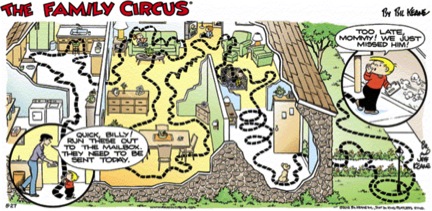
Wait. What Was My Point?
Behold, my desktop.

As I write this, I have the following windows open on my laptop: four browser tabs, including my igHome homepage, my Gmail inbox, Pandora (currently set to Yo-Yo Ma Radio, of all things), and Workamajig (wherein I am diligently, faithfully, and without fail recording my timesheet every day as far as you know). Meanwhile, I have three Word documents open (including this one) along with Outlook for my work calendar and email plus Skype for when email is just not fast enough. (Hang on a second. . . . Sorry. I’m back.) Alongside my laptop sits my smartphone, a perfectly serviceable but conspicuously out-of-style iPhone with (it turns out) 9 other apps currently working to drain my battery: Mail, Phone, Weather, Facebook Messenger (for corresponding with my daughter in New Zealand), Podcasts, Calendar, Contacts, Messages, and Words with Friends (on which I’m currently beating my daughter 357-269). On the side of my desk rests another phone that is so old-fashioned it plugs into the wall. Beside me rests a copy of Fortune magazine (unopened) and another mostly-read copy of Fast Company. All of these things are vying for my attention—the fact that they are present and humming and near at hand is sufficient proof that most have gotten at least a short burst of consideration within the last 18 hours or so. They pull at me throughout the day, as does the growing stack of papers and other detritus associated with the various projects I’m working on. (Excuse me. Gotta talk to Amber. . . . Where was I? Oh, yeah.) Most of these things—designed to make life and work easier and more enjoyable—even have built in mechanisms to remind me that they are there in case I have, for a moment, turned my attention to something else. When an email comes in, a window appears at the bottom of my screen saying: “Read me!” There are an array of pings and chimes to signal that someone wants an instant answer to her instant message or a chance to get my opinion on something I wasn’t thinking about just moments before. Even Pandora, for which I gladly pay a few bucks a year to have background music uninterrupted by commercials, interrupts itself periodically to stomp its feet and demands some eye contact: “Are you still listening?” All of these alerts and devices produce a false sense of urgency—as if the speed of delivery and access requires an equal level of responsiveness. The consequence is the sort of disjointed distraction that is the enemy of productivity. Tell me if this sounds at all familiar: Say you’re writing a blog post when Faithful Co-worker 1 Skypes to ask when that meeting is. You stop writing to check your calendar when a pop-up window appears reminding you of another meeting that starts in 15 minutes. Remembering that you were supposed to bring that one document to the meeting, you search your email for the attachment that includes the document in question. Before long you’re hip deep in emails, answering this and forwarding that. And that doesn’t even account for the unscheduled visits from Faithful Co-workers 2, 3, 4, and 5, all of whom need just a quick minute of your time to get your POV on this or your signature on that or your acknowledgment that the Ducks have a much better chance of winning the Stanley Cup than the Blackhawks. Which they do. (Wait. What was my point? Oh, yes, I was writing a blog post.) It’s just that easy to become one of those old Family Circus comic strips in which Billy has wandered off while ostensibly making a quick trip to the mailbox.

And let’s be clear: No one has ever aspired to be in The Family Circus. This is the truth behind the myth of our multi-tasking, always-on age of wireless wonder and open-office collaboration. Best case scenario, doing several things at once with multiple gadgets and a swirl of other activity all around you means doing several things merely adequately. Best case. The fact is that really good work requires focus, and focus requires detachment from everything but the one thing you’re working on right now. Thus the word focus. (Time out. Text from my buddy. . . . Hilarious. Sorry about that.) In September, the Wall Street Journal put the impact of interruption into terms that even Billy could understand. Citing multiple studies, the Journal said that on average we get barely 12 minutes and 40 seconds to dedicate to a task before we’re interrupted, and then it takes nearly a half an hour before we can return to the task—with another 15 required to get us “back into the same level of intense concentration.” Ten hours later we reach the end of the day and wonder what we’ve accomplished. “I know I’ve been busy, but where did my day go?” So here’s my suggestion for making the day at least somewhat more productive (and satisfying) than it probably is right now:
- Turn off all desktop alerts.
- Force yourself to focus on one thing at a time until it’s done. No checking email mid-PowerPoint.
- Whenever you’re tempted to interrupt a co-worker, schedule a quick visit instead.
- Remember: Almost everything can wait.
- Make sure . . .
(Hang on. Kelly just dropped by my office. This should only take a couple of minutes. . . .)


